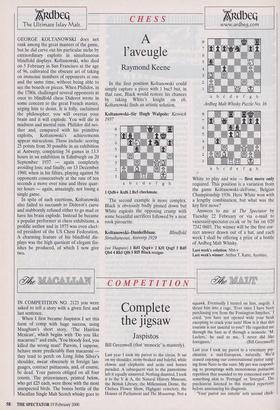Rdbeq The Ultimate Islay Malt.
Rdbeq
www.ardbeg.com
CHESS
A raveugle
Raymond Keene
GEORGE KOLTANOWSKI does not rank among the great masters of the game, but he did carve out his particular niche by extraordinary exploits in simultaneous blindfold displays. Koltanowski, who died on 5 February in San Francisco at the age of 96, cultivated the obscure art of taking on immense numbers of opponents at one and the same time, without being able to see the boards or pieces. When Philidor, in the 1780s, challenged several opponents at once to blindfold chess Diderot wrote in some concern to the great French master, urging him to desist. It is folly, exclaimed the philosopher, you will overtax your brain and it will explode. You will die in madness and mental ruin. Philidor did nei- ther and, compared with his primitive exploits, Koltanowski's achievements appear miraculous. These include: scoring 25 points from 30 possible in an exhibition at Antwerp; completing 34 games in 13.5 hours in an exhibition in Edinburgh on 20 September 1937 — again completely avoiding loss; and finally, on 13 December 1960, when in his fifties, playing against 56 opponents consecutively at the rate of ten seconds a move over nine and three quar- ter hours — again, amazingly, not losing a single game.
In spite of such exertions, Koltanowski also failed to succumb to Diderot's curse and stubbornly refused either to go mad or have his brain explode. Instead he became a popular performer at chess exhibitions, a prolific author and in 1975 was even elect- ed president of the US Chess Federation. A charming feature of his blindfold dis- plays was the high quotient of elegant fin- ishes he produced, of which I now give two. In the first position Koltanowski could simply capture a piece with 1 bxc5 but, in that case, Black would restore his chances by taking White's knight on c6. Koltanowski finds an artistic solution.
Koltanowski–Sir Hugh Walpole: Keswick 1937 The second example is more complex. Black is obviously badly pinned down but White exploits the opposing cramp with some beautiful sacrifices followed by a neat rook pirouette.
Koltanowski–Dunkelblum: Blindfold Simultaneous, Antwerp 1929 (see Diagram) 1 Rdl Qxg4 + 2 lc n QxgS 3 Rd5 Qh4 4 Rh5 Qf6 5 Rf5 Black resigns White to play and win — first move only required. This position is a variation from the game Koltanowski–deFosse, Belgian Championship 1936. Here White won with a lengthy combination, but what was the key first move?
Answers to me at The Spectator by Tuesday 22 February or via e-mail to vanessa@spectator.co.uk or by fax on 020 7242 0603. The winner will be the first cor- rect answer drawn out of a hat, and each week I shall be offering a prize of a bottle of Ardbeg Malt Whisky.
Last week's solution: Nb6+ Last week's winner: Arthur T. Katte, Ayrshire.


































































 Previous page
Previous page